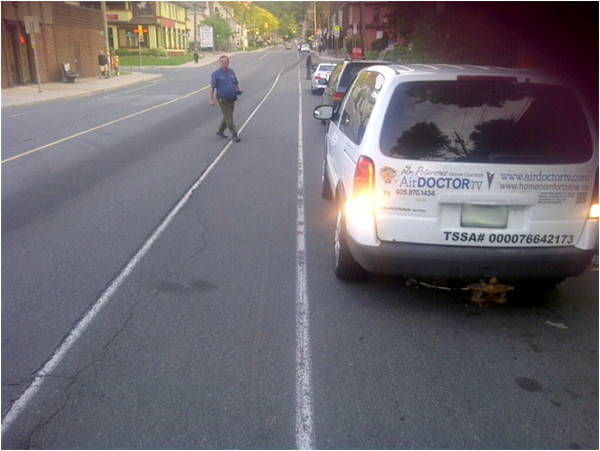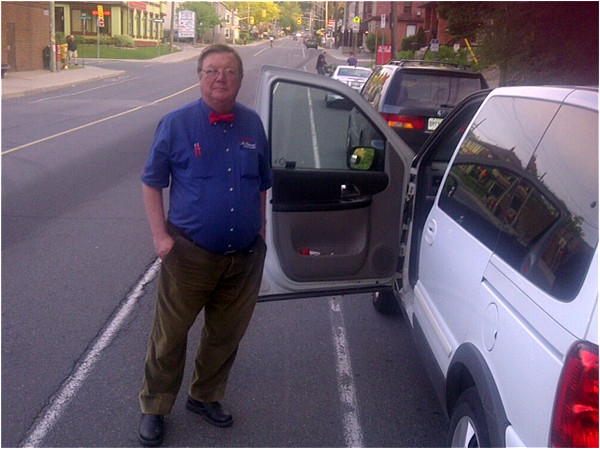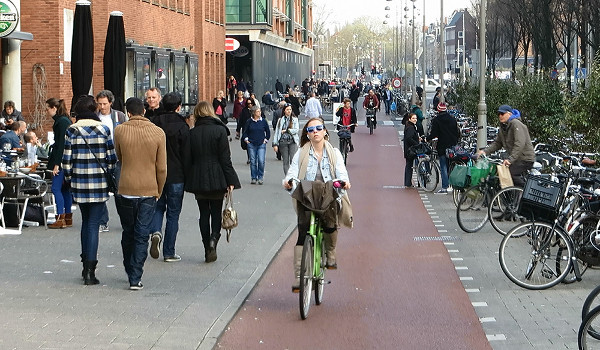For bike lane design, one of the key elements of conflict that must be removed to ensure safety is the threat of dooring.
By Kevin Love
Published July 04, 2014
The Netherlands is famous for getting transportation right. The bicycle mode share is 27 percent for all trips in the country as a whole, including rural areas. For Central Amsterdam, this rises to 70 percent. Most importantly, The Netherlands has the safest roads in the world.
As we saw in Part I of this series, elimination of conflict is a critical part of the Dutch concept of Sustainable Safety. This is safety that is engineered into the transportation infrastructure to mistake-proof it against human error.
For bike lane design, one of the key elements of conflict that must be removed to ensure safety is the threat of dooring.
The normal method of death is a car driver negligently opens a car door without checking for people approaching in the bike lane. The opening door strikes the cyclist, throwing the victim out of the cycle lane in front of a moving motor vehicle, which then crushes and kills the victim.
Last year, there were 92 dooring incidents in Montreal, two of which resulted in the death of the victim.
In the years 1997-98 there were 276 doorings in Toronto, which accounted for 11.9% of all crashes. 3.1% of these doorings resulted in major injuries and there was one fatality.
We do not have any more recent data, because police in Toronto and other Ontario cities stopped collecting dooring data.
Even although Ontario police stopped collecting data, people are still being killed in dooring incidents
This brings us to Hamilton, where dangerous conflict is frequently designed into our bike lanes by routing them into the door zone of adjacent parked cars.
Below are two photographs recently taken on Dundurn Street South.
In the first photo, we can see that the cars are all parked more-or-less the same. This is how the City of Hamilton is instructing car drivers to park their cars. This particular car was only chosen because the car driver was returning and agreed to hold the door open while I took a photograph.

Photo 1: Car parked on the west curb on Dundurn Street South
In the second photograph, we see the consequences of this dangerous-by-design infrastructure. The open car door extends over half of the bicycle lane.
If a car driver should negligently fail to check for approaching traffic before opening the door, the all-too-frequent result is another dooring tragedy.

Photo 2: Car parked on the west curb on Dundurn Street South with door opening into southbound bike lane
The Dundurn bike lane is dangerous-by-design infrastructure where the most dangerous place on the entire road to ride a bicycle is in the bike lane.
First, Dutch bicycle traffic design engineering standards explicitly discourage ("expliciet ontraden") putting a bike lane next to parked cars. Where this absolutely must happen, there is a minimum buffer of 0.75 metres between the car parking and bike lane to protect people from the door zone.
Jodenbreestraat in Amsterdam is an excellent example of how a car-clogged people-hostile street was reclaimed by its citizens.
Before WWII, this was a bustling street through the heart of Amsterdam's Jewish quarter. Most of its inhabitants perished during the war, so the post-war city government faced little opposition in destroying enough buildings to create a Hamilton-style four lane road for cars.
Then in the 1970s, the people started to reclaim their city. Plans to destroy even more buildings to extend the road for cars were defeated, and the street was reclaimed for people, not cars.
Two excellent descriptions (one with video) by two different people may be seen here and here. Notice how there are almost no cars parked on the street and zero with bicycle traffic in their door zone.

Jodenbreestraat in 2014 (Image Credit: Bicycle Dutch)
The key point to note is how an ugly, Hamilton-style, people-hostile car sewer was transformed into a prosperous and happy place for people.
They changed. We can too.
By z jones (registered) | Posted July 04, 2014 at 14:51:11
Love this series! Please keep them coming. I haven't had any dooring close calls on the south bound lane but I've had to swerve out around a few cars (mostly taxis in front of the beer store) blocking the north bound bike lane.
By DowntownInHamilton (registered) | Posted July 04, 2014 at 21:05:26
I'm all for abolishing the curb parking there. It's for the lazy, those who don't want to pull into the LCBO or beer store parking lot, or onto the side streets to park.
A friend lives right at that intersection and I'm there at least once a week. I've only seen the LCBO and beer store parking lots at capacity a few times. Mostly it's people who can't be bothered to make the turn into the lots and just park on the street there.
Are you suggesting though the closure of the street along that section of Dundurn?
By rednic (registered) | Posted July 05, 2014 at 09:06:10
Of course the dutch are taught to open their car doors with the opposite hand.
Makes dooring an obsolete concept.
By KevinLove (registered) | Posted July 05, 2014 at 13:36:18 in reply to Comment 103007
Although true, this is a product of a previous iteration of safety thinking, before the introduction of Sustainable Safety (“Duurzaam veilig” in Dutch) in 1997. There are five principles of Sustainable Safety that may be seen by following the link. For those who speak Dutch, there is a good description on Wikipedia, and the official website is here.
Perhaps the most important principle is that of mistake-proofing ("Vergevingsgezindheid"). Anyone who has ever worked in one of Hamilton's factories will recognize this principle, because it underlies the Ministry of Labour's approach to industrial safety. The goal is to mistake-proof against human error. Error that is due to human beings being distracted, tired, in a rush, impaired or experiencing human emotions such as anger or aggression.
In a factory it is unacceptable to have, for example, an exposed moving saw blade without a guard. If an employee is injured by such a blade, management cannot say, "We put up a warning sign and trained that employee about the danger. It is the employees fault!" On the contrary, the Ministry of Labour will say "You failed to put up a guard as a physical barrier to prevent the injury. It is management's fault."
The exact same approach is taken by the Dutch to road safety. Dangerous conflict must be designed and engineered out of the street infrastructure. As we see in Jodenbreestraat, this is done by removing cars from dangerous conflict with people. One example is removing the door zones of parked cars from bicycle traffic.
Comment edited by KevinLove on 2014-07-05 13:40:03
By beancounter (registered) | Posted July 05, 2014 at 13:46:07
Almost makes you want to advocate "wrong-way parking", which unfortunately carries its own serious risks.
Would it not be possible to have the bike lane next to the curb? Oh wait! That would be an inconvenience to car drivers and passengers. It certainly would motivate car occupants to look very carefully for approaching bicycles, though.
By KevinLove (registered) | Posted July 05, 2014 at 14:00:47 in reply to Comment 103004
That section of Dundurn is a shopping street, like Jodenbreestraat. My suggestion is that Dundurn be opened up to people. People who are currently excluded from the street. Non-protected cycle infrastructure will only be used by theStrong & Fearlesswhich is <1% of the population and the Enthused & Confident, another 7%.
Right now, Dundurn Street excludes 92% of the population from using it. That really should change.
By KevinLove (registered) | Posted July 05, 2014 at 18:07:15 in reply to Comment 103010
Parking protected bike lanes are quite common in New York City. For example, see any of the following, ending with a bicycle parking protected bike lane:
http://www.streetfilms.org/how-complete-...
http://www.streetsblog.org/2012/10/03/to...
http://www.streetsblog.org/2012/06/07/ey...
http://www.streetsblog.org/2013/06/10/a-...
http://www.streetfilms.org/a-bike-parkin...
Comment edited by KevinLove on 2014-07-05 18:08:12
By KevinLove (registered) | Posted July 05, 2014 at 18:14:50 in reply to Comment 103014
Here is a really good video explaining how New York City used parking protected cycle lanes. Notice the Dutch-style buffer zone protecting cyclists from the car's door zone.
http://www.streetfilms.org/floating-park...
I must add that although this treatment is a giant step forward from what we have in Hamilton, it is still second-class by Dutch standards. The Dutch discourage car parking next to cycle traffic in the first place for two reasons:
Comment edited by KevinLove on 2014-07-05 18:35:17
By mikeonthemountain (registered) | Posted July 05, 2014 at 18:34:05 in reply to Comment 103009
Recently when our employer was refreshing our OHSA training, the irony was not lost on me. Some of our streets and routes are no-brainers for unsafe work refusals, if employment standards were applied to the public realm.
By DowntownInHamilton (registered) | Posted July 05, 2014 at 18:38:19 in reply to Comment 103011
I'd disagree that the section right there is a shopping area - 220 Dundurn (on the east side, where the curb parking is) is a vacant, derelict building that shows no signs of ever being re-purposed, regardless of what Vranich the Younger says.
The actual "people" part would be farther down, from, say, Herkimer to Aberdeen. From Main to Charlton it's houses, industrial stuff (Car repair, car lots, a gas station, Cable 14, etc).
The stretch south of Charlton is the real people area.
By KevinLove (registered) | Posted July 05, 2014 at 21:43:25 in reply to Comment 103017
Perhaps I should write "failed shopping street." Which was exactly what Jodenbreestraat was in the 1970's. The "before and after" photos are quite telling.
Right now, Dundurn is definitely looking like the "before" photos. They changed. We can too.
By DowntownInHamilton (registered) | Posted July 06, 2014 at 07:41:55 in reply to Comment 103017
Sorry - 220 Dundurn is on the _West_ side, not the east.
By highwayman (anonymous) | Posted July 07, 2014 at 11:20:25
An interesting side note is that a driver in Amsterdam can get himself into extreme trouble if he hits a cyclist. Unfortunately, cyclists here in Hamilton have no protection from the law.
By DowntownInHamilton (registered) | Posted July 09, 2014 at 21:33:11 in reply to Comment 103039
What a ridiculous comment.
By Vincent (anonymous) | Posted July 10, 2014 at 16:05:24
Protected Bike Lanes Double in U.S. Cities’ Bid for Youth - Bloomberg News
bloomberg.com/news/2014-07-10/protected-bike-lanes-double-in-u-s-cities-bid-to-attract-youth.html
You must be logged in to comment.
There are no upcoming events right now.
Why not post one?